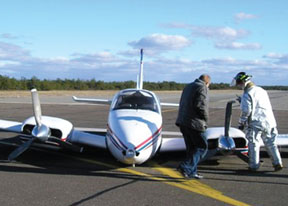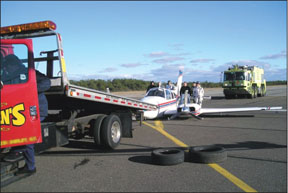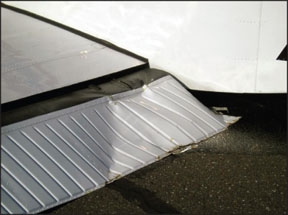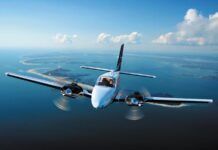by Jon Doolittle
Its a groaner weve all heard: There are those who have and those who will land with the gear in the wells. The notion is absurd, of course. All of us know plenty of pilots whove retired from flying having never scratched an airplane, let alone scrubbing the antennas off with the million-dollar runway slide.

Gear-up landings happen to pilots of all experience levels, but there’s good evidence that it tends to be a high-timer type of mishap for reasons we don’t fully understand. Landing gear accidents are more of an embarrassment than a serious safety problem because people rarely get hurt and the airplane is (usually) repairable. But gear-up landings represent a substantial percentage of the cost of flying, not only to insurers, but to owners and pilots. We cant tell you exactly how much it will cost if you land with the wheels up, but we know from unfortunate history what will need to be replaced. As shown in the charts on page 21, the financial carnage is staggering and as an owner, you’ll pay for some of it. In gathering numbers for this article, we spoke with shops around the country and looked at a range of light general aviation airplanes using actual repair invoice totals. Gear-ups are more expensive than ever.
Bent MetalGear-up landings begin with the violent meeting of propeller and pavement, which requires the removal of the prop and the engine, referred to as R&R (removal and reinstallation). Most shops that do a lot of this work have either a flat rate, depending upon the engine type, or else a good idea of how much time each R&R will require.
Propellers involved in these accidents can rarely be repaired, so there are three possibilities: If one is available, you may opt to replace it with a used overhauled prop. But since shops are often required to scrap the hub as we’ll as the blades, the supply of used propellers is dwindling.
Option two is to replace the propeller with a new one of the same type from the original equipment manufacturer. These are generally available but can be expensive. Choice three is a new STCd propeller, which are available for most airplanes and are priced between new OEM replacements and used overhauled props.
Because most variable pitch props are made by either Hartzell or McCauley, one is usually the OEM and the other competing with a lower cost STCd challenger. We think the STC props are a good value, but we would urge owners considering one to ask around among other pilots with similar airplanes who have made the change to see what they think. Unlike propellers, engines can usually be saved after a gear-up landing, but require a teardown inspection, including examination or replacement of a number of engine-driven accessories, including vacuum pumps and magnetos. Some shops quote with these items included and some don’t. Always ask.
The teardown inspection focuses on the bottom end of the engine and the cost varies with type and size of engine, with the number of cylinders the chief variable in teardown price. A typical teardown quote includes a flat labor charge as we’ll as a list of parts that must be replaced in order to legally assemble the engine.
The final invoice will include parts and labor associated with any other damage found during the inspection which is not related to the gear-up landing, but which must be addressed before assembling the engine, such as corrosion, a distressingly common finding typically not paid for by insurers. (More on this later.)
In addition to the teardown cost, you’ll have damage to other parts of the airplane, mostly those components that took over for the tires. This varies with the type of airplane and how we’ll the pilot finessed the landing. When airplanes skid off the runway and encounter signs, lights or trees, the ante goes up. Pilots who flip the gear switch down midway through the event find that the gear motor wont pick the airplane up, but will be strong enough to do a great deal of damage to the retraction system.
The big damage cost variable is type of airplane. Some types have most of the damage confined to a few easily replaced components. Several shops that we talked to told us that Bonanzas often ride down the runway on the nosebowl and the step, grinding away the inboard corner of the flaps, nosebowl and the bottom of the step, doing little other damage.
Another shop said that Cessna 210s tended to cost more to repair since they slide along on the belly, requiring a great deal more sheet metal work, new antennas, gear doors and the like. Twins will obviously cost more to fix because there are two props and two engines.Amphibians are the other side of the landing-gear accident coin. Forgetting the gear in an amphibian when landing on land usually leads to a very short landing roll, some scraped paint and not much else. Often, the keel strips don’t even need to be replaced. The big no-no in amphibians is extending the gear before a water landing, the dreaded “gear-down” landing. This ends with the airplane pitching forward and capsizing. In salt water, this usually leads to a total loss. And its one type of landing-gear accident where people can and often do get hurt.
Who Pays?While insurers bear most of the immediate burden for these accidents-and its a big number-they know about how often its going to happen and how much it will cost. They have collected their money in advance, have it set aside earning interest and are just waiting for the phone to ring. This isn’t the case for owners.
The first cost that an owner bears is his in-motion deductible. These typically range from $0 to $2500 for landplanes and are substantially more for amphibians, frequently as much as 10 percent of the airplanes value.
Another expense some owners have to pick up is the cost of “betterment.” Insurance contracts are meant to restore the airplane to the same state it was in before the accident. If repairs result in increasing the value of the airplane, insurers may ask the owner contribute to the extent that the airplane has received betterment.

Like engines, propellers have recommended intervals between overhauls, expressed either in hours of service or years installed. Unlike engines, propellers arent normally repairable, but must be overhauled or replaced with new units. This is where betterment raises its head.
Heres how it works: If you have a propeller with a 1500-hour TBO and you land with the wheels up when it has been in service for 1200 hours, your insurance payout will give you a zero-time propeller. But your insurer may ask you to chip in 4/5ths of the cost of an overhaul. Bear in mind that the pro-ration is based upon the cost of the overhaul and not the cost of the replacement propeller. In the world of gear-up landings, the prop shops overhaul price is largely irrelevant except for this calculation.
Some insurers prorate propeller overhauls and some don’t. Most told us they didnt bother unless the propeller had high time or was run out when it was damaged. Several adjusters told us that they had fairly wide latitude in settling claims and that often, the way they approached a claim depended upon the attitude of the owner. Most said that they give more consideration to a pilot whos reasonable to deal with, who admits his mistake and seems to have learned something from the episode.
Engine damage not related to the gear-up thats discovered in the course of a teardown inspection is also the owners burden. Engine shops told us that they found unrelated damage in 70 to 90 percent of the engines that they tore down, ranging from minor corrosion to cracks in the crankcase to killer ADs that required replacement of major components. The amount of damage found tends to increase as the engine accumulates time since its last overhaul. In our example, we assume that both engine and propeller have 1000 hours since the last overhaul.
Lost ValueAnother item to run up the cost of a gear-up is the loss of resale value due to damage history in your logbook. Until you sell your airplane, this isn’t a cash cost and the size of it depends on several factors. In general, older airplanes take less of a damage history hit, since a larger proportion of similar airplanes have also been damaged at one time or another. Other factors include the kind of damage that the airplane suffered, the way that repairs are done and the reputation of the shops that did the repairs.
Replacement of parts is less an issue than repairing the same parts. But regardless, an airplane that has suffered a gear-up landing will bring a lower price than a similar serial number that has not, so sooner or later, that cost will become real. In the chart, we used 8 percent of the Bluebook value for airplanes built in 1990 and 6 percent for those built earlier.
Owners who have gonged their insurers for gear-ups can expect to pay higher insurance premiums at their next renewal and for a couple of years afterward. Most companies told us that they looked for rate increases that ranged from 10 to 25 percent. One company told us that if the owner had suffered his first slide and had been with the company for a number of years, they often didnt increase premiums after a gear accident.
In general, most other companies who would otherwise compete for your business will refrain from offering quotes the very next year so that the company that paid the claim can get at least a token return. Typically, insurers will fork over between 10 and 25 years of premium in a typical gear-up landing, so they know they cant recover much of it from you. Nonetheless, expect higher premiums for the next couple of years.
The most painful cost for owners who fly often is the loss of use during repair. Repair time depends upon how badly the airplane was damaged, but also how quickly everyone involved steps through filling out forms, reviewing repair bids and sending out components for repair. Often, the process is held up by the availability of a propeller or other part, or by backlogs in engine and prop shops. The duration of the repairs also seems to vary according to where in the country repairs are being made.
One adjuster told us that there werent as many shops doing major repair work in the northeast as there were 10 years ago and he has had to ship damaged airplanes south or west for repairs. Its also our impression that airplanes get fixed more quickly in those parts of the country.
We based our estimates on time out of service on conversations with shops, insurance brokers and adjusters. We think that three months is typical for a garden variety gear-up landing, given the amount of work that the repair shop has to send out.
Flying AgainAnother cost to keep in mind is the price of getting back in the saddle. After not flying for three months or more, budget some dual. Your insurer may require it and if they don’t, it will help with your renewal if they know youre trying to make yourself a safer pilot.
Keep in mind that not all of the costs in our chart will apply to you. Not everyone has deductibles and many insurers wont pro-rate the life on your propeller. Not every engine will have unrelated damage. But these are real numbers, taken from real invoices and, in the aggregate, this is what we think will happen.
If you find yourself in this situation, there are some things that you can do to minimize the damage to your wallet. First, be mindful that all claims situations are negotiations. Be prepared for some give and take. Most adjusters will do whatever they can to help if they feel that youre being reasonable and taking responsibility for what happened. Adjustors have seen hundreds of gear-up landings. If you forgot to put the wheels down, just fess up. They have to pay, either way.

Be involved in the process of getting your airplane back on its feet. We cant stress this one enough. In even the most straightforward claims, there are decisions to be made. Youre the one who has to pick the shop to do the repairs, the engine facility for the teardown and the prop shop. If you arent sure where to start, ask the people who maintain your airplane.
If your engine is beyond mid-time, it makes sense to apply the insurance teardown money to an overhaul. Maybe it makes sense for you to spend an extra $1000 to upgrade from a used overhauled version of your old propeller to a new STCd propeller.
Each step of the way, look at your options. Think about how each decision will affect the overall cost of repairs, the time it will take to do them and their effect on your airplanes resale value. Make certain that your insurance company is in agreement with your decisions before you execute them. If there are items that each of you will pay for, make sure everyone is clear on who is paying how much for what.
If you bought your insurance through an aviation insurance broker, get his or her help. Unlike auto or homeowners insurance agents, brokers are literally your paid representative rather than an agent of the company. Claims advice is part of what you have paid commission for and the good specialists have been through the drill many times.
If you do suddenly find yourself on the other side of the line between those who will and those who have, remember that as bad as you feel about it, your flying life will continue. As long as airplanes are flown by human beings subject to distraction, complacency, fatigue and forgetfulness, there will be those who have, and those who hope they wont.
-Jon Doolittle owns Sutton James Insurance in Hartford, Connecticut.





